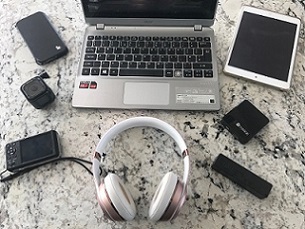 E-cigarette. Photo by InspiredImages from Pixaby free photos website.
E-cigarette. Photo by InspiredImages from Pixaby free photos website.
 All these everyday personal electronic devices are powered by lithium-ion batteries
All these everyday personal electronic devices are powered by lithium-ion batteries
 An AvSax lithium-ion fire mitigation bag which is now on board thousands of aircraft worldwide to improve transport safety in the air
An AvSax lithium-ion fire mitigation bag which is now on board thousands of aircraft worldwide to improve transport safety in the air
E-cigarettes are to blame for fires on board 3 aircraft in just five days … even though people aren’t allowed to vape on board.
The problem is the vapes are powered by lithium-ion batteries which can go faulty and catch fire.
According to the Federal Aviation Administration (FAA) in the USA, this has happened three times in just 5 days in February this year and in one instance left a crew member badly burned.
He was on board an air ambulance helicopter when lithium batteries caught fire … in his pocket.
The ferocity of the fire and searing heat generated by the battery fire left the crew member on the Air Evac Lifeteam aircraft with second and third degree burns and needing hospital treatment. Air Evac Lifeteam is the largest independently owned air ambulance service in the United States with more than 125 bases.
The other two vape incidents happened on large passenger aircraft. An e-cigarette in a passenger’s bag went into thermal runaway while the plane was in the air. A small fire was extinguished by the cabin crew and the item placed in a thermal containment bag
In the second emergency an e-cigarette went into thermal runaway during a flight from Los Angeles to Chicago. It was submerged in water and again placed inside a thermal containment bag.
If the fires had caught hold they could have had catastrophic consequences in the confined space of aircraft passenger cabins at 30,000ft.
These 3 incidents are among the latest reported to the FAA in the USA about lithium battery fires so far in 2022. Lithium-ion batteries are used to power all modern personal electronic devices including mobile phones, laptops and iPads.
This means there have been 354 aviation related incidents involving lithium batteries carried as cargo or baggage recorded by the FAA since January 2006. These are just the events that the FAA is aware of – there may well have been many more.
Thermal runaway happens when one cell in a battery overheats it can produce enough heat – up to 900°C (1652°F) – to cause adjacent cells to overheat. This can cause a lithium battery fire to flare repeatedly and they are very difficult to put out which is why AvSax battery fire containment bags are needed.
AvSax (http://avsax.com/) are the world’s best-selling fire containment bag for PEDs on aircraft and are now on more than 15,373 aircraft operated by 80 airline companies.
They have been used 33 times to deal with emergencies since the start of 2017 and every time they have been deployed the aircraft has been able to complete its journey safely with no need to divert or make an emergency landing. Diversions can be very costly to the airline company and can even run into hundreds of thousands of dollars.
Many air ambulance helicopters in the UK now carry AvSax. More than 20 helicopters operated by specialist aerial emergency medical services company Babcock were equipped with AvSax following a detailed look into the possible risks posed by lithium-ion batteries on aircraft.
AvSax won the prestigious Queen’s Award for Enterprise in the UK in 2018.